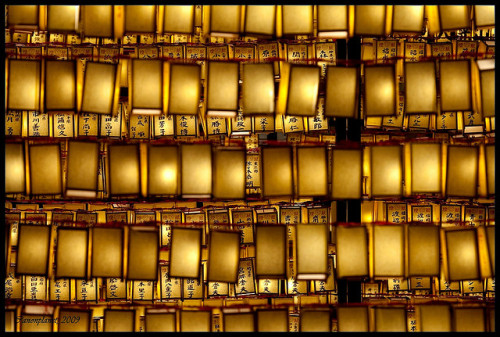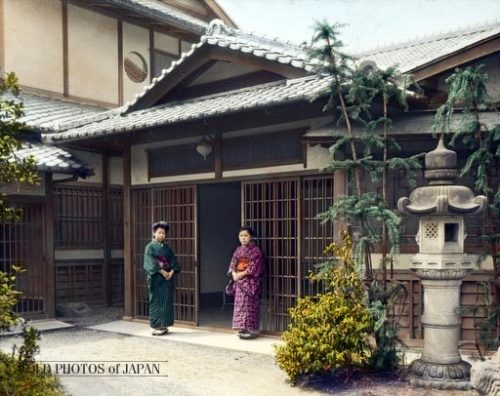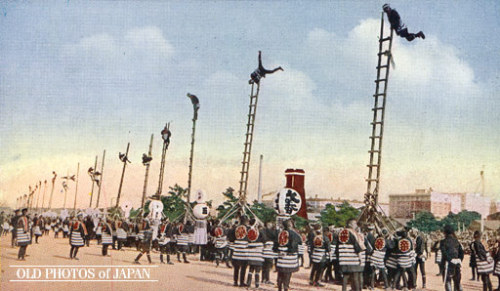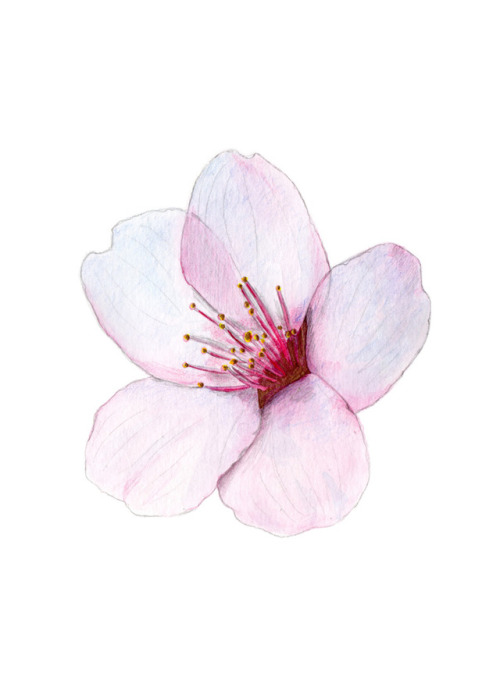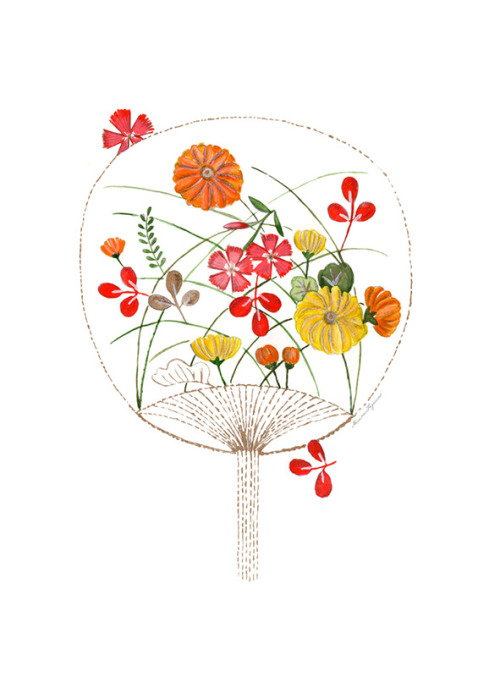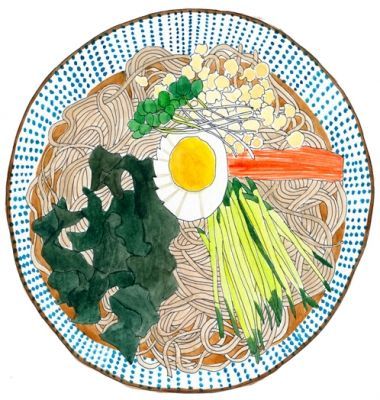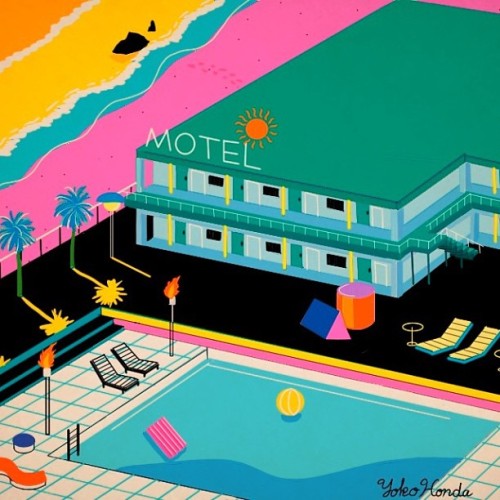#japanese culture



This is heaven.
You can listen the sound of the stream while you soak in the hot spring.
川のせせらぎを聴きながら入る温泉、極楽。。。♨️
Heart-pia Myoban, Beppu-city, Oita
大分県別府市 ハートピア明礬



Cold weather makes me want to eat “Dango-jiru”.
寒い日はだんご汁食べたくなるね





Yuzuyu on the day of the winter solstice.
It is said that you will not catch a cold
“Yuzuyu” refers to the bath in which yuzus are put and set afloat.
Citrus-based flavor of yuzu makes me feel relaxed.
冬至の日にゆず湯
風邪を引かないと言われています。
ゆず湯とはゆずを浮かべたお風呂の事です。
ゆずの柑橘系の香りがリラックスさせてくれます♨️
Shimogori onsen, Oita-city
大分市 下郡温泉


Some very skilled Masseurs give you Shiatsu massage.
腕のいい按摩師が指圧してくれる。
Only 3200yen for a hour.
1時間3200円!
Futaba Massage in Beppu
双葉マッサージ、別府




Plum wine flavored with black tea
紅茶梅酒
My mom’s favorite
母のお気に入り☆
Nakano Brewing Company in Kitsuki-City, Oita
中野酒造 大分県杵築市
Geisha credit picture: maiko Katsuhana of Gion Kobu by osa_liberal on Instagram
Edited by me :)
Post link

A test for an illustration I want to draw!
I have been busy with school lately, and can’t really juggle tumblr and instagram at the same time :/ I’m awful at managing social media, smh…









Dollfie Dream Dynamite and Large Chest Type Kimono Fox Girl. I want to try it on my future SD Girl. Alice’s Collections.





Mini Dollfie Dream Kimono. Tempted to try this on one of my girls. Alice’s Collections



Mini Dollfie Dream and ¼th MSD Kitsune Kimono. Alice’s Collections.

Dollfie Dream Dynamite and Large Chest SD Floral Kitsune Kimono. I’m tempted to try this on my future SD Girl. Alice’s Collections.
1920s Japan in handcoloured photographs.
Top: A view of Numa River and Mount Fuji as seen from Tagonoura in Shizuoka Prefecture
Middle: Entrance way to a traditional Japanese wooden built home
Bottom: Firefighters show off their agility performing acrobatic stunts on ladders.
All courtesy of Old Photos of Japan
Post link
http://japlanning.wordpress.com/2013/06/19/kotoshi-dinner-in-the-ponto-cho/
I thought it was so enchanting :)
Blog about Japan? Use Bunch to share your blog with more japan fans.
Signup free to get more blog followers and comments.
Posted by Kally Whitehead.
Great article on The Monsieur: ‘The Story of Sebiro: How Japan Re-invents the West’. ‘It may not seem like it but for a while Japan was taking on tech and auto behemoths, pioneers in the industry and beating the big players at their own game. Whether it was Sony with the Walkman or Toyota with high build quality and fuel efficiency, Japan was showing the West how it was done. But unknown to all but a minority of well-dressed, swank-living gentlemen, another secret front was developing- Japan was taking elements of Western culture: the Savile Row suit (In kanji: ‘Sebiro’ is a direct translation of the English name – more on that in a bit), Scottish Whiskey and American denim and re-inventing them with the same artisanal dedication to Japanese precision found on objets d’art like Grand Seiko. Japan was once again beating the West at their own game.’

I have always been known as the person who starts a venture and jump from one to the other without totally mastering any particular field. In the astrological point of view of the Western and Chinese cultures, it must be primarily caused by the position of celestial objects at the time of my birth. I was born under the zodiac Gemini (the twins known to have split personalities) and the year of the Metal Horse (impulsive in productivity). After all, I’m part Chinese and it’s my second nature to involve astrology every time I get the chance.
One of these ventures engages in different cuisines to further enhance my culinary skills. Today, I was so delighted to spend my free day from work to prepare a sumptuous and complete meal for my family. I decided to do it completely Japanese! It may look like a laborious and dull domestic chore, but it’s actually therapeutical and pleasurable to do. Results of hard work in the kitchen are best harvested when you see the people savouring the food with every bite. Nothing beats the rewarding and pleasurable feelings out of making other people happy. I think it’s one of the best lessons I still bear in mind from my Home Economics teacher way back in high school.
Anyway, here are the photos of every dish I prepared for our dinner.

Presenting our menu:
- Miso soup
- Salmon Sashimi (sliced salmon)
- Gunkanmaki (warship roll)
- Shrimp nigiri
- California maki
- A variety of makizushi (sushi rolls)
- Ebi Tempura (shrimp)
- Nasu Tempura (eggplant)
- Satsuma Imo Tempura (Sweet potato)
- Tamagoyaki (fried egg roll)
- Green tea ice cream

Individual Platter: (L-R) California maki, Makizushi, (T-B) Ebi Tempura, Satsuma Imo Tempura, Nasu Tempura and a ball of Japanse rice.
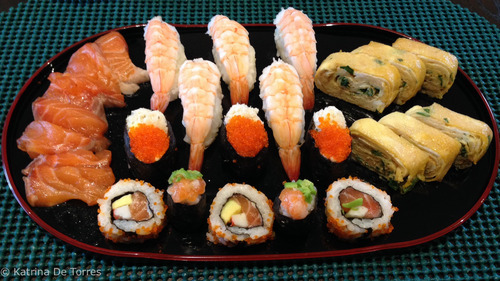
To share Platter A: (L-R) Salmon Sashimi, California Maki, two kinds of Gunkanmaki, Shrimp Nigiri and Tamagoyaki.
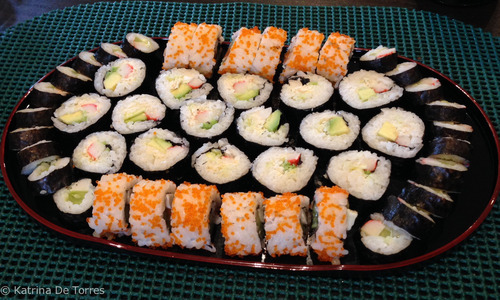
To Share Platter B: California Maki and A variety of Makizushi
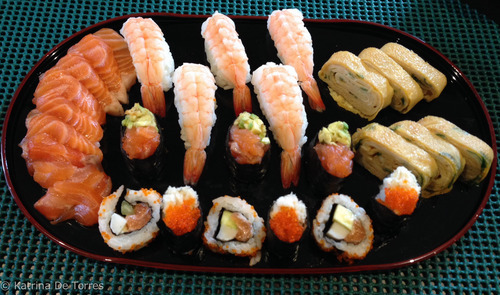
To share Platter C: (L-R) Salmon Sashimi, California Maki, two kinds of Gunkanmaki, Shrimp Nigiri and Tamagoyaki.
Platter C is almost the same as Platter A. The only difference are the kinds of Gunkanmaki included.

Dessert: Green tea ice cream (to cap off the lovely night)
On the side note: I was dreadful the day before thinking of the worst, which is not finding any tuna available in any store nearby. Lo and behold, there was no available tuna everywhere!!! It’s my first time preparing a complete Japanese meal without a tuna so I settled with salmon instead.
I’m proud to say that all of my culinary skills were either self-taught or passed on to me by my parents. Neither of my parents work for the industry (both CPAs) but our family and extended family are very passionate in cooking! Plus, it’s a common Filipino culture for families and relatives to dine in together in every possible meal. Thus, it’s a pleasure to be preparing food for large groups of people. I never received any formal trainings in Japanese cuisine and in anything about cooking/baking in general but I’m longing to have one. Practical work may be the best way to learn but not when it isn’t backed up with theoretical knowledge. It has always my been principle when it comes to learning. Both must go hand in hand.
A little history on how I started, I first prepared sushi when I was in high school. My dad bought me a simple hard-bound sushi book with the most basic recipes. There were only less than 10 recipes on it, and one of them is how to prepare the rice - the most important ingredient! I started with a simple bamboo sushi mat as my tool, tried the other kinds that promise to do the task faster and more efficiently, but as I go along, I decided to stick to the very first one I had - the bamboo mat!
Then after several trial and errors accompanied by my research on basic readings of How-Tos and different techniques from different chefs and culinary enthusiasts, I learned to develop my own style, which is the one that suits my needs and my skills best.
Basic knowledge in absolutely everything is at the tip of our fingers with the power of Internet. Gone are the days of literally dragging ourselves to the library (which includes catching up with their closing time) just to satisfy our hunger for information. With great power comes with great responsibility… and of course, opportunity!
Don’t you love our generation? We can utilise whatever we have to enhance our skills efficiently and conveniently!
FYI, I also learned my Adobe Photoshop and Illustrator skills just by reading tutorials through the Internet. ;) I’m very much grateful for it!
Estas exquisitas acuarelas fueron realizadas originariamente, por Miriam Figueras, para ilustrar unos cuentos escritos por mí y ambientados en la ciudad japonesa de Kakunodate.
En mi opinión las ilustraciones son tan bellas y delicadas que merecen ser contempladas por sí mismas. Espero que estéis de acuerdo conmigo.
Ilustraciones de Miriam Figueras
Post link
Natsuko Imai es una ilustradora japonesa, cuyos trabajos acabo de encontrar. Me encanta la ilustración y si el objeto de la misma es la gastronomíaaún más. Esta obra me parece digna de mención. Aunque el idioma original del blog de Natsuko Imai es el japonés, merece una visita para contemplar sus magníficos dibujos. Aquí está el enlace.
Post link
Yoko Honda (8 de junio de 1984) es una artista contemporánea japonesa. Su trabajo está basado en la ilustración digital. Sus trabajos representan una vuelta la década de los 80 a través de las formas y, sobre todo, del color.
Me ha impresionado el fantástico colorido de toda su obra. Me transmite energía y optimismo.
Imagenes vía Melt
Post link

